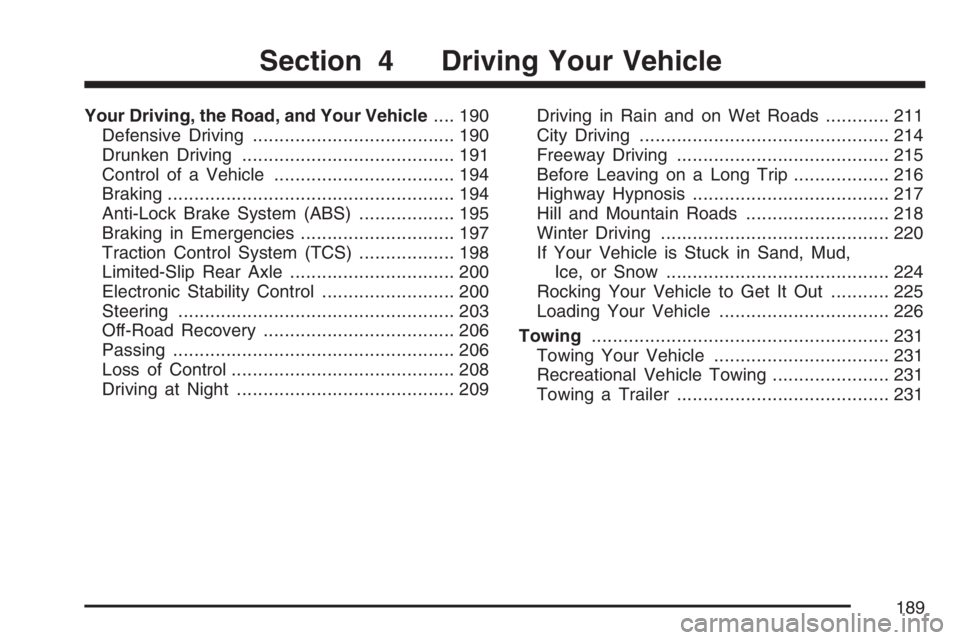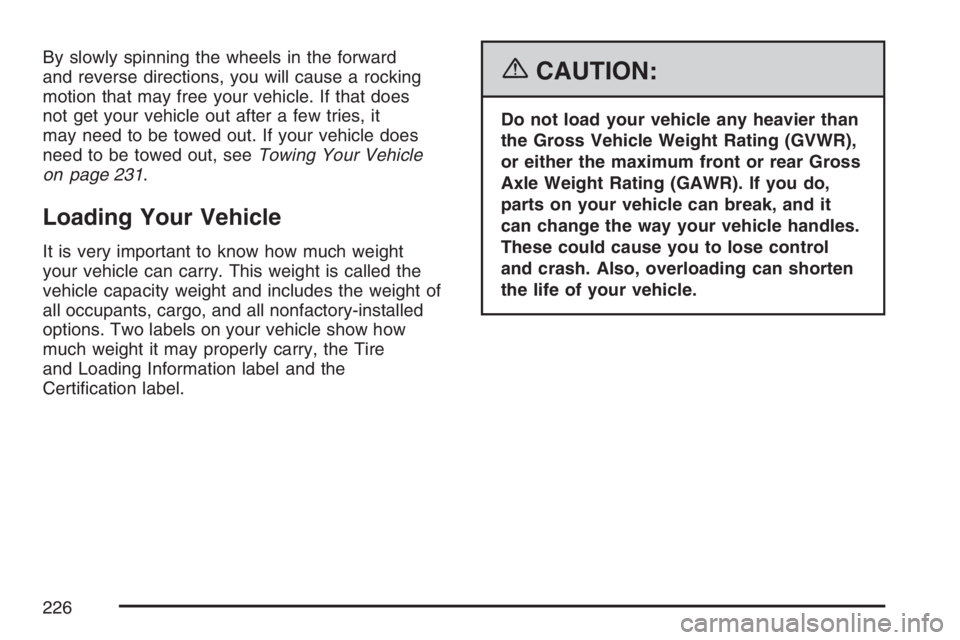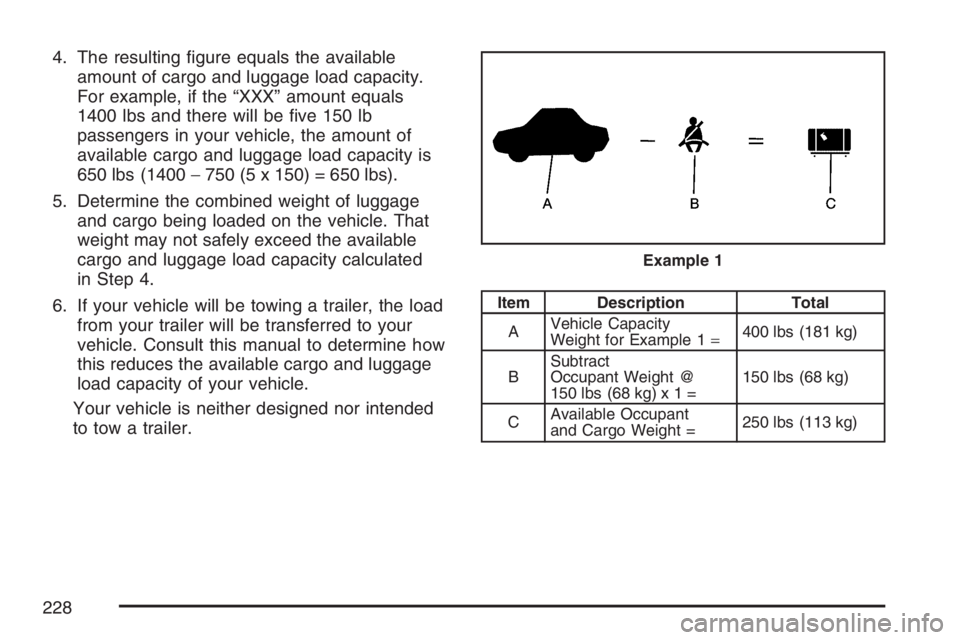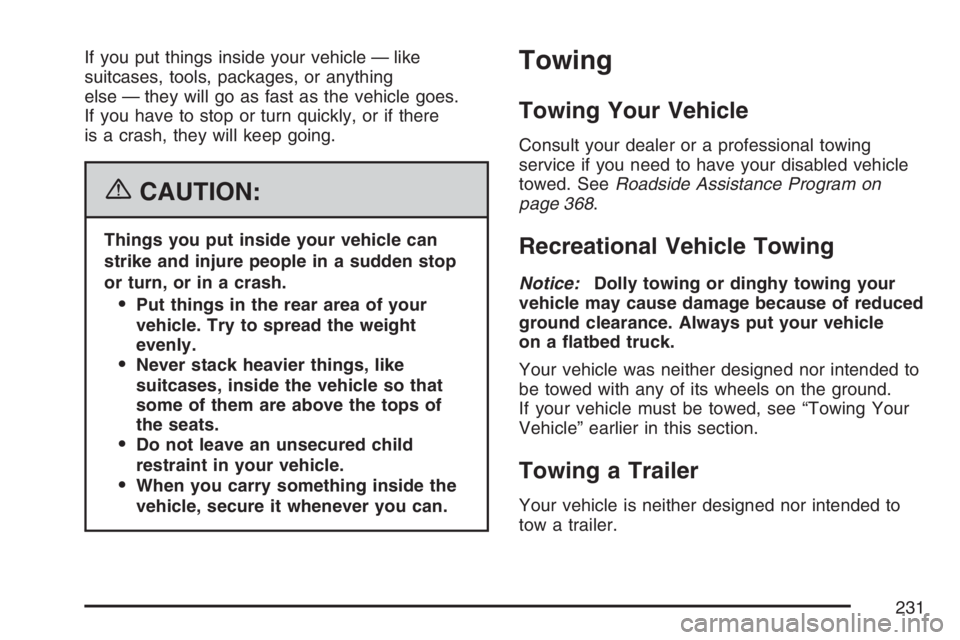tow PONTIAC SOLSTICE 2007 User Guide
[x] Cancel search | Manufacturer: PONTIAC, Model Year: 2007, Model line: SOLSTICE, Model: PONTIAC SOLSTICE 2007Pages: 396, PDF Size: 2.27 MB
Page 112 of 396

Turn and Lane-Change Signals
The turn signal has two upward (for right) and
two downward (for left) positions. These positions
allow you to signal a turn or a lane change.
To signal a turn, move the lever all the way up or
down. When the turn is �nished, the lever will
return automatically.
An arrow on the
instrument panel cluster
will �ash in the
direction of the turn or
lane change.
To signal a lane change, raise or lower the lever
until the arrow starts to �ash. Hold it there until you
complete your lane change. The lever will return
by itself when you release it.As you signal a turn or a lane change, if the
arrows �ash rapidly, a signal bulb may be burned
out and other drivers will not see your turn
signal. If a bulb is burned out, replace it to help
avoid an accident.
If the arrows do not go on at all when you signal a
turn, check the fuse. SeeFuses and Circuit
Breakers on page 326.
Headlamp High/Low-Beam Changer
To change the headlamps from low beam to high
beam, push the turn signal lever away from you.
When the high beams
are on, this light on the
instrument panel
cluster will also be on.
To change the headlamps from high beam to low
beam, pull the turn signal lever toward you.
112
Page 113 of 396

Flash-to-Pass
This feature lets you use your high-beam
headlamps to signal a driver in front of you that
you want to pass.
To use it, pull the turn signal/multifunction lever
toward you until the high-beam headlamps
come on, then release the lever to turn them off.
Windshield Wipers
Use this lever, located on the right side of the
steering wheel, to operate the windshield wipers.
9(Off):Move the lever to this position to turn off
the windshield wipers.
&(Intermittent; Speed Sensitive
Wipers):Move the lever to this position for
intermittent or speed sensitive operation. When
you select this position, the delay will vary
depending on the vehicles speed, as well as the
manually selected delay.
x(Delay):When the lever is in the intermittent
position, turn the intermittent adjust band with
this symbol on it up or down to set for a shorter or
longer delay between wipes. To the left of the
adjust band are bars, increasing in size from
bottom to top, that indicate the frequency of the
wipes. Smaller bars mean the wipers movement is
less frequent. Larger bars mean the movement
is more frequent.
6(Low Speed):Move the lever up to the
�rst setting past intermittent, for steady wiping at
low speed.
1(High Speed):Move the lever up to the
second setting past intermittent, for wiping at
high speed.
113
Page 135 of 396

When the ignition is on, the brake system warning
light will also come on when you set your parking
brake. The light will stay on if your parking brake
does not release fully. If it stays on after your
parking brake is fully released, it means you have
a brake problem.
If the light comes on while you are driving, pull off
the road and stop carefully. Make sure the parking
brake is fully released. You may notice that the
pedal is harder to push or, the pedal may go closer
to the �oor. It may take longer to stop. If the light is
still on, have the vehicle towed for service.
SeeTowing Your Vehicle on page 231.
{CAUTION:
Your brake system may not be working
properly if the brake system warning light
is on. Driving with the brake system
warning light on can lead to an accident.
If the light is still on after you have pulled
off the road and stopped carefully, have
the vehicle towed for service.
Anti-Lock Brake System
Warning Light
Your vehicle may have
the Anti-Lock Brake
System (ABS).
This light will come on when your engine is
started and may stay on for several seconds.
That is normal.
135
Page 189 of 396

Your Driving, the Road, and Your Vehicle.... 190
Defensive Driving...................................... 190
Drunken Driving........................................ 191
Control of a Vehicle.................................. 194
Braking...................................................... 194
Anti-Lock Brake System (ABS).................. 195
Braking in Emergencies............................. 197
Traction Control System (TCS).................. 198
Limited-Slip Rear Axle............................... 200
Electronic Stability Control......................... 200
Steering.................................................... 203
Off-Road Recovery.................................... 206
Passing..................................................... 206
Loss of Control.......................................... 208
Driving at Night......................................... 209Driving in Rain and on Wet Roads............ 211
City Driving............................................... 214
Freeway Driving........................................ 215
Before Leaving on a Long Trip.................. 216
Highway Hypnosis..................................... 217
Hill and Mountain Roads........................... 218
Winter Driving........................................... 220
If Your Vehicle is Stuck in Sand, Mud,
Ice, or Snow.......................................... 224
Rocking Your Vehicle to Get It Out........... 225
Loading Your Vehicle................................ 226
Towing........................................................ 231
Towing Your Vehicle ................................. 231
Recreational Vehicle Towing...................... 231
Towing a Trailer........................................ 231
Section 4 Driving Your Vehicle
189
Page 226 of 396

By slowly spinning the wheels in the forward
and reverse directions, you will cause a rocking
motion that may free your vehicle. If that does
not get your vehicle out after a few tries, it
may need to be towed out. If your vehicle does
need to be towed out, seeTowing Your Vehicle
on page 231.
Loading Your Vehicle
It is very important to know how much weight
your vehicle can carry. This weight is called the
vehicle capacity weight and includes the weight of
all occupants, cargo, and all nonfactory-installed
options. Two labels on your vehicle show how
much weight it may properly carry, the Tire
and Loading Information label and the
Certi�cation label.
{CAUTION:
Do not load your vehicle any heavier than
the Gross Vehicle Weight Rating (GVWR),
or either the maximum front or rear Gross
Axle Weight Rating (GAWR). If you do,
parts on your vehicle can break, and it
can change the way your vehicle handles.
These could cause you to lose control
and crash. Also, overloading can shorten
the life of your vehicle.
226
Page 228 of 396

4. The resulting �gure equals the available
amount of cargo and luggage load capacity.
For example, if the “XXX” amount equals
1400 lbs and there will be �ve 150 lb
passengers in your vehicle, the amount of
available cargo and luggage load capacity is
650 lbs (1400−750 (5 x 150) = 650 lbs).
5. Determine the combined weight of luggage
and cargo being loaded on the vehicle. That
weight may not safely exceed the available
cargo and luggage load capacity calculated
in Step 4.
6. If your vehicle will be towing a trailer, the load
from your trailer will be transferred to your
vehicle. Consult this manual to determine how
this reduces the available cargo and luggage
load capacity of your vehicle.
Your vehicle is neither designed nor intended
to tow a trailer.
Item Description Total
AVehicle Capacity
Weight for Example 1=400 lbs (181 kg)
BSubtract
Occupant Weight @
150 lbs (68 kg) x 1 =150 lbs (68 kg)
CAvailable Occupant
and Cargo Weight =250 lbs (113 kg) Example 1
228
Page 231 of 396

If you put things inside your vehicle — like
suitcases, tools, packages, or anything
else — they will go as fast as the vehicle goes.
If you have to stop or turn quickly, or if there
is a crash, they will keep going.
{CAUTION:
Things you put inside your vehicle can
strike and injure people in a sudden stop
or turn, or in a crash.
Put things in the rear area of your
vehicle. Try to spread the weight
evenly.
Never stack heavier things, like
suitcases, inside the vehicle so that
some of them are above the tops of
the seats.
Do not leave an unsecured child
restraint in your vehicle.
When you carry something inside the
vehicle, secure it whenever you can.
Towing
Towing Your Vehicle
Consult your dealer or a professional towing
service if you need to have your disabled vehicle
towed. SeeRoadside Assistance Program on
page 368.
Recreational Vehicle Towing
Notice:Dolly towing or dinghy towing your
vehicle may cause damage because of reduced
ground clearance. Always put your vehicle
on a �atbed truck.
Your vehicle was neither designed nor intended to
be towed with any of its wheels on the ground.
If your vehicle must be towed, see “Towing Your
Vehicle” earlier in this section.
Towing a Trailer
Your vehicle is neither designed nor intended to
tow a trailer.
231
Page 247 of 396

A. Windshield Washer Fluid Reservoir. See
“Adding Washer Fluid” underWindshield
Washer Fluid on page 269.
B. Coolant Surge Tank and Pressure Cap. See
Cooling System on page 262.
C. Brake Master Cylinder Reservoir. See “Brake
Fluid” underBrakes on page 270andHydraulic
Clutch on page 256.
D. Engine Oil Dipstick. See “Checking Engine Oil”
underEngine Oil on page 247.
E. Engine Air Cleaner/Filter. SeeEngine Air
Cleaner/Filter on page 254.
F. Engine Oil Fill Cap. See “When to Add Engine
Oil” underEngine Oil on page 247.
G. Power Steering Fluid Reservoir. SeePower
Steering Fluid on page 268.
H. Remote Negative (−) Ground (Out of View).
SeeJump Starting on page 274.
I. Battery (Out of View). SeeBattery on page 273.
J. Remote Positive (+) Terminal. SeeJump
Starting on page 274.
K. Underhood Fuse Block. SeeUnderhood Fuse
Block on page 329.Engine Oil
Checking Engine Oil
It is a good idea to check the engine oil every time
you get fuel. In order to get an accurate reading,
the oil must be warm and the vehicle must be
on level ground.
The engine oil dipstick handle is a yellow loop.
SeeEngine Compartment Overview on page 244
for the location of the engine oil dipstick.
1. Turn off the engine and give the oil several
minutes to drain back into the oil pan. If you
do not do this, the oil dipstick might not
show the actual level.
2. Pull the dipstick and clean it with a paper
towel or cloth, then push it back in all the
way. Remove it again, keeping the tip down
and check the level.
247
Page 295 of 396

After the tires have been rotated, adjust the front
and rear in�ation pressures as shown on the
Tire and Loading Information label. SeeLoading
Your Vehicle on page 226for an example of
the Tire and Loading Information label and
its location on your vehicle. Make certain that all
wheel nuts are properly tightened. See “Wheel
Nut Torque” underCapacities and Speci�cations
on page 332.
{CAUTION:
Rust or dirt on a wheel, or on the parts to
which it is fastened, can make wheel nuts
become loose after a time. The wheel
could come off and cause a crash. When
you change a wheel, remove any rust or
dirt from places where the wheel attaches
to the vehicle. In an emergency, you can
use a cloth or a paper towel to do this;
but be sure to use a scraper or wire brush
later, if you need to, to get all the rust or
dirt off.
When It Is Time for New Tires
One way to tell when it
is time for new tires is
to check the treadwear
indicators, which will
appear when your tires
have only 1/16 inch
(1.6 mm) or less of
tread remaining.
You need a new tire if any of the following
statements are true:
You can see the indicators at three or more
places around the tire.
You can see cord or fabric showing through
the tire’s rubber.
The tread or sidewall is cracked, cut, or
snagged deep enough to show cord or fabric.
The tire has a bump, bulge, or split.
The tire has a puncture, cut, or other damage
that cannot be repaired well because of the
size or location of the damage.
295
Page 300 of 396

Your dealer will know the kind of wheel you need.
Each new wheel should have the same
load-carrying capacity, diameter, width, offset
and be mounted the same way as the one
it replaces.
If you need to replace any of your wheels, wheel
bolts or wheel nuts, replace them only with
new GM original equipment parts. This way,
you will be sure to have the right wheel, wheel
bolts and wheel nuts for your vehicle.
{CAUTION:
Using the wrong replacement wheels,
wheel bolts, or wheel nuts on your vehicle
can be dangerous. It could affect the
braking and handling of your vehicle,
make your tires lose air and make you
lose control. You could have a collision
in which you or others could be injured.
Always use the correct wheel, wheel bolts,
and wheel nuts for replacement.Notice:The wrong wheel can also cause
problems with bearing life, brake cooling,
speedometer or odometer calibration,
headlamp aim, bumper height, vehicle ground
clearance, and tire clearance to the body
and chassis.
{CAUTION:
Rust or dirt on a wheel, or on the parts to
which it is fastened, can make wheel nuts
become loose after a time. The wheel
could come off and cause a crash. When
you change a wheel, remove any rust or
dirt from places where the wheel attaches
to the vehicle. In an emergency, you can
use a cloth or a paper towel to do this;
but be sure to use a scraper or wire brush
later, if you need to, to get all the rust or
dirt off.
300